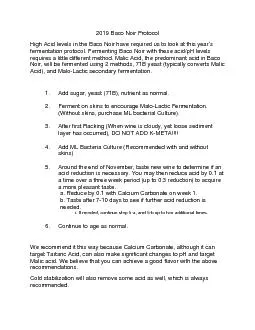

High Acid levels in the Baco Noir have required us to look at this year s fermentation protocol Fermenting Baco Noir with these acidpH levels requires a little different method Malic Acid ID: 854577
Download Pdf The PPT/PDF document "2019 Baco Noir Protocol" is the property of its rightful owner. Permission is granted to download and print the materials on this web site for personal, non-commercial use only, and to display it on your personal computer provided you do not modify the materials and that you retain all copyright notices contained in the materials. By downloading content from our website, you accept the terms of this agreement.
1 2019 Baco Noir Protocol High Acid leve
2019 Baco Noir Protocol High Acid levels in the Baco Noir have required us to look at this year ’ s fermentation protocol. Fermenting Baco Noir with these acid/pH levels requires a little different method. Malic Acid, the predominant acid in Baco Noir , will be fermented using 2 methods, 71B yeast (typically converts Malic Acid), and Malo - Lactic secondary fermentation. 1. Add sugar, yeast (71B), nutrient as normal. 2. Fer ment on skins to encourage Malo - Lactic Fermentation. (Without skins, purchase ML bacter ial Culture). 3. After first Racking (When wine is cloudy, yet loose sediment layer has occurred), DO NOT ADD K - META!!!! 4. Add ML Bacteria Culture (Recommended with and without skins) 5. Around the end of November, ta ste new wine to determine if an acid reduct ion is necessary. You may then reduce acid by 0.1 at a time over a three week period (up to 0.3 reduction) to acquire a more pleasant taste. a. Reduce by 0.1 with Calcium Carbonate on week 1. b. Taste after 7 - 10 days to see if further acid reduction is n eeded. i. If needed, continue step 5 - a, and 5 - b up to two additional times. 6. Continue to age as normal. We recommend it this way because Calcium Carbonate, although it can target Tartaric Acid, can also make significant changes to pH and target Malic acid. We believe that you can achieve a good flavor with the above recommendations. Cold stabilization will also remove some acid as well, w hich is always recommended.